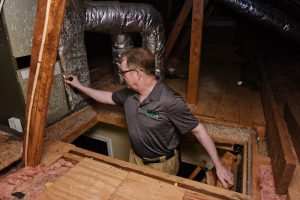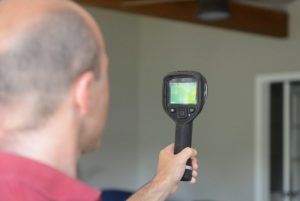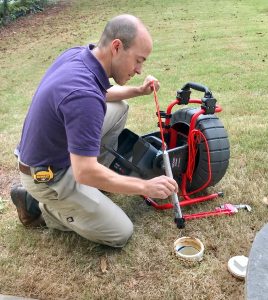1

- Roof, Attic, Insulation & Ventilation
- Plumbing & Electrical Systems
- Siding, including hardcoat and synthetic stucco (EIFS)
- Appliances
- Heating & Cooling Systems
- Foundation (Slabs, Block wall, Poured Concrete)
- Walls, Ceilings, Windows, Doors
- Garages & Driveways
- Thermal scan (Infrared) of interior for hidden moisture, electrical issues and insulation problems
- Decks/Porches
2
–Infrared Building Inspections
Infrared building inspections are a fast and noninvasive way to identify and document problem areas that may not be visible to the naked eye, and we use an infrared camera on every inspection — at no additional charge. Infrared thermography is the use of an infrared thermal imaging camera that can “see” and “measure” the invisible heat (thermal) energy that is emitted by all objects and produces thermal images (called thermograms) that can identify the thermal anomalies that represent the potential problem areas. Water intrusion, moisture problems, heat/energy loss, air infiltration, 
Infrared inspections can be tailored to evaluate interiors, exteriors, roofing and entire buildings or can be focused on a specific area, such as water intrusion/moisture problems, energy efficiency, electrical systems and structural systems. Weather conditions prior to or during the inspection and time of day can have a dramatic effect on the accuracy of the infrared inspection or whether the inspection can be performed at that time. Exterior inspections cannot be accurately performed in rainy or windy conditions as it alters the surface temperatures of the components and does not allow for a true thermal picture. Most roofing inspections are performed in the evening after the roofing material has cooled. Long periods of no rain prior to the inspection may prevent discovery of water intrusion or moisture problems because the materials were dry at the time of the inspection and did not show a difference in surface temperature. Ideally, there should be a 15 to 20-degree temperature difference between the inside and outside to provide the most accurate thermographic images.
3
To best assure proper construction of new homes, we recommend having two inspections performed: One before drywall is installed and another once the home is completed. This type of phase inspection, although more expensive than a single inspection, helps to ensure your home is constructed properly.
4
We used to believe scoping was only needed on older homes with those “past-their-life” cast iron. But we were amazed at how often problems were found on newer PVC drain piping. Even new construction! Tree roots, poor installation and settling can really affect your buried sewer pipes, so having it scoped ahead of time can save you THOUSANDS of dollars. Just ask anyone who has had to deal with sewer pipe replacement.
What a great video from our friends at Structure Tech in Minnesota on just what can be found…even on newer drain pipes: https://structuretech1.com/sewer-inspections-old-new/
We offer both residential and commercial sewer scoping services using one of the most state-of-the-art sewer cameras on the market–it’s better than what most plumbing companies use, and we charge less! We take videos and can mark the location of any clogged or damaged area of your sewer drain piping. Our reports include estimates to use in negotiations with the seller. 
5
– Radon Testing (Courtesy of Radon.com)
Radon is a cancer-causing radioactive gas. You cannot see, smell or taste radon, but it may be a problem in your home. The Surgeon General has warned that radon is the second leading cause of lung cancer in the United States today. If you smoke and your home has high radon levels, you’re at high risk for developing lung cancer. Some scientific studies of radon exposure indicate that children may be more sensitive to radon. This may be due to their higher respiration rate and their rapidly dividing cells, which may be more vulnerable to radiation damage.
We use a more detailed continuous-monitoring device that provides hourly and average readings. Data is downloaded directly from the device to our computers for immediate results after 48 hours.
Here are areas that we have tested as having elevated levels of Radon See Map. You can also see radon levels here.
6
– Pest and Termite Inspections
Termites and critters and bugs! Oh my! Find out if the house you fell in love with is also loved by termites and other pests. We’re very pleased to have partnered with our friends at Arrow Exterminators to provide this service.
7
We’ve partnered with local pool companies who provide our clients swimming pool inspections that include pumps, liners (when visible) and controls. Service areas vary so please call for pricing and to see if your area is covered.
8
– Pre-Listing Inspections (a.k.a Seller’s Inspection)
Homes that have been pre-inspected and then had issues corrected prior to being placed “For Sale” have a much better chance of being sold quickly as the buyer gains a sense of comfort with the home right away. It also minimizes any surprises when the buyer gets their own inspection done on the home.
9
Are you interested in knowing if there are high levels of mold in the air you are breathing inside the home? We offer air quality testing for mold as an additional service. This is a good way to find out if there is unhealthy air in the home as well as hidden leaks behind walls that may be causing excessive mold growth.
10
–Multi-Family Rental Property Inspections
We provide comprehensive multi-family rental property inspections tailored to meet the needs of property owners, managers, and HOAs. Whether you’re looking to maintain property value, ensure tenant safety, or comply with local inspection ordinances, our detailed assessments cover both interior and exterior components. We identify potential issues early, helping you stay proactive with maintenance and avoid costly repairs. Trust our certified inspectors to deliver clear, actionable reports that support the long-term success of your rental communities.